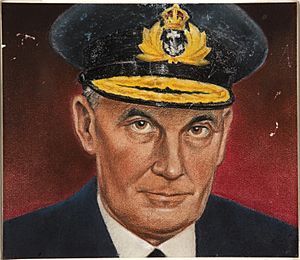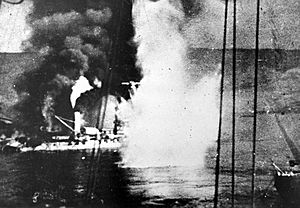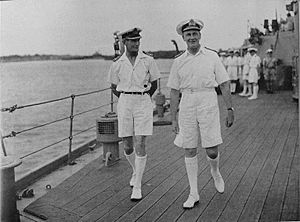James Somerville facts for kids
Quick facts for kids
Sir James Somerville
|
|
|---|---|

Admiral Sir James Somerville c. 1943
|
|
| Born | 17 July 1882 Weybridge, Surrey |
| Died | 19 March 1949 (aged 66) Dinder House, Somerset |
| Buried |
St Michael and All Angels Church, Dinder
|
| Allegiance | United Kingdom |
| Service/ |
Royal Navy |
| Years of service | 1897–1946 |
| Rank | Admiral of the Fleet |
| Commands held | Eastern Fleet (1942–44) Force H (1940–42) Battlecruiser Squadron (1940) East Indies Station (1938–39) Destroyer Flotillas, Mediterranean Fleet (1936–38) HMS Norfolk (1931–32) HMS Barham (1927–29) HMS Warspite (1927) HMS Benbow (1922–23) |
| Battles/wars | |
| Awards | Knight Grand Cross of the Order of the Bath Knight Grand Cross of the Order of the British Empire Distinguished Service Order Mentioned in Despatches (2) Knight Grand Cross of the Order of Orange-Nassau (Netherlands) Commander of the Legion of Merit (United States) |
Admiral of the Fleet Sir James Fownes Somerville (17 July 1882 – 19 March 1949) was a very important officer in the Royal Navy. He served in both the First World War and the Second World War. During World War I, he helped with naval support for the Gallipoli Campaign. In World War II, he led a special group of ships called Force H. He was involved in a difficult mission to deal with the French fleet at Mers El Kébir and later played a key role in finding and sinking the famous German battleship, the German battleship Bismarck.
Somerville later became the leader of the Eastern Fleet. In 1942, his fleet faced a strong attack by the Japanese in the Indian Ocean raid. However, by 1944, with more ships, he launched successful air attacks against Japanese forces. He spent the end of the war working for the British Navy in Washington, D.C., in the United States.
Contents
Early Life and Family
James Fownes Somerville was born on 17 July 1882 in Weybridge, Surrey. His father, Arthur Fownes Somerville, was a lawyer and lived at Dinder House in Somerset. James married Mary Main in 1913. They had a daughter and a son. His son, John Arthur Fownes Somerville, also served in the Royal Navy. The well-known news reader Julia Somerville is one of his granddaughters.
James Somerville began his naval training on the ship HMS Britannia in 1897. He quickly moved up the ranks, becoming a sub-lieutenant in 1901 and a lieutenant in 1904. He served on several ships, including HMS Royal Arthur and HMS Warspite. He also worked on developing wireless telegraphy (early radio communication) at the torpedo school HMS Vernon.
Service in World War I
During the First World War, Somerville was a wireless officer. He served on battleships like HMS Marlborough and HMS Queen Elizabeth. He helped provide naval support during the Gallipoli Campaign, a major battle in Turkey. For his bravery and service, he was promoted to commander in 1915 and received the Distinguished Service Order.
Between the World Wars
After World War I, Somerville continued his naval career. He became an Executive Officer on battleships in the Mediterranean Fleet. In 1921, he was promoted to captain. He worked at the British Admiralty, which is the headquarters of the Royal Navy, as Deputy Director of Signals. He also commanded ships like HMS Norfolk. In 1933, he became a rear admiral and worked on improving welfare for sailors. He was made a Companion of the Order of the Bath in 1935.
In 1936, he became Flag Officer Destroyers in the Mediterranean Fleet. He even commanded an international force during the Spanish Civil War. He was promoted to vice admiral in 1937 and became the leader of the East Indies Station. He retired briefly in 1939 due to illness but was soon called back to duty.
World War II: European Operations

As World War II began, Somerville returned to the British Admiralty. He did important work on developing radar technology. In May 1940, he helped organize the Dunkirk evacuation, where many Allied soldiers were rescued from France.
His next big job was leading the new Force H, based in Gibraltar. After France made peace with Germany in 1940, Winston Churchill gave Somerville a very tough order. He had to make sure the French fleet at Mers El Kébir in Algeria would not fall into German hands. If the French refused to cooperate, he was told to attack their ships.
Somerville felt this was a terrible task, but he followed his orders. On 3 July 1940, Force H attacked the French ships. They sank the battleship Bretagne, causing many deaths. Other French ships were also damaged. The operation was seen as a success, but Somerville was sad about having to fight former allies.
Somerville then led British forces in the Battle of Cape Spartivento in November 1940. He also played a crucial part in the famous hunt for and sinking of the German battleship, the German battleship Bismarck, in May 1941. He was honored for his service with Force H in October 1941.
World War II: Indian Ocean Operations
In March 1942, Somerville became the leader of the Eastern Fleet. He was promoted to full admiral. After the fall of Singapore, he moved his fleet's headquarters from Trincomalee in Sri Lanka to Kilindini Harbour in Kenya.
In April 1942, a powerful Japanese fleet launched the Indian Ocean raid. Somerville's fleet suffered heavy losses, including an aircraft carrier and two cruisers. However, because he had been warned by intelligence, he moved his main ships out of harm's way before the Japanese attacks. This helped save the Eastern Fleet's most important ships from being destroyed.
By spring 1944, with more ships and aircraft, Somerville was ready to go on the attack. He led a series of strong air strikes against Japanese-held areas in the Dutch East Indies. These included attacks on Sabang in April and May 1944, and on Surabaya in May 1944. For his leadership, he received another high honor, the Knight Grand Cross of the Order of the Bath, in August 1944.
Later Career and Retirement
In October 1944, Somerville was put in charge of the British naval team in Washington, D.C., USA. He managed to work very well with Admiral Ernest King, a tough American naval leader. He was promoted to Admiral of the Fleet in May 1945. He also received high awards from the Netherlands and the United States.
After retiring from the Navy in 1946, Somerville became the Lord Lieutenant of Somerset. He lived at his family home, Dinder House, in Somerset. He passed away on 19 March 1949, and was buried in the churchyard of St Michael and All Angels Church in Dinder.



